In a previous blog, we defined on-time mobility and provided the framework (Sabet, 2022) for the benefits of using assistive technology or modified toys to enable children to move themselves in space. When children are unable to initiate movement, they are often pushed in a stroller or a wheelchair or are carried. The experiences for learning and processing sensory input is fundamentally different than when a child has active control of movement in space and explores the environment independently (Feldner et al., 2015; Field et al., 2015; Kenyon et al., 2002; Kenyon et al., 2018).
Evidence demonstrates that independent mobility is linked to cognitive, social, motor, language, and other developmental benefits in young children (Adolph, 2020; Casey, 2013; Nilsson et al., 2003; Pellichero et al., 2021; Rosen et al., 2017). One of the more popular toy modifications is to move the foot pedal in a ride-on car to another position that would allow a child to make the car stop and go. Matt Larsen, the Director of the Illinois Spina Bifida Association, has coordinated the GoBabyGo builds for individuals and groups for more than 10 years. He observes that modified cars enhance the ability for a child to participate in movement activities to explore, socialize, and even experience some mischief typical for a child that age (Rivera, 2024). Lisa Kenyon (2015) and her physical therapy students interviewed parents who expressed the same views.
This idea of modifying a car was popularized by Professor Cole Calloway as part of a research project at the University of Delaware and is called GoBabyGo (University of Delaware). The program has international status and is often a project of high school science, technology, engineering, art, and math (STEAM) programs, scouts, or adult philanthropic organizations such as Kiwanis (University of Delaware).
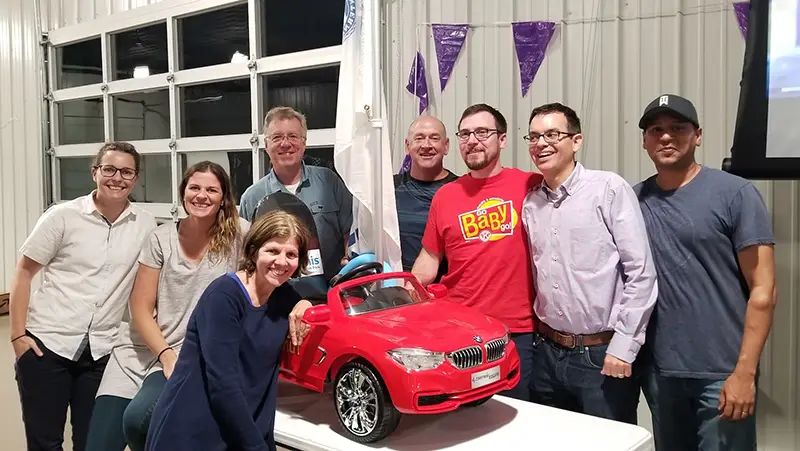 2018 GoBabyGo build and fundraiser event sponsored by Kiwanis with Cole Galloway (fourth from right) as a keynote speaker. Matt Larsen (second from right) from Illinois Spina Bifida Association organized the event. Shirley Ryan Ability engineers and therapists oversaw the modified car build.
2018 GoBabyGo build and fundraiser event sponsored by Kiwanis with Cole Galloway (fourth from right) as a keynote speaker. Matt Larsen (second from right) from Illinois Spina Bifida Association organized the event. Shirley Ryan Ability engineers and therapists oversaw the modified car build.
For the last 10 years, I participated in GoBabyGo builds for up to 20 cars at a time. They were housed at the Oak Park Illinois Shriners Hospital, funded by the Oak Park Kiwanis Club, and organized by the Illinois Spina Bifida Association with engineering oversight and therapeutic input for the Rehabilitation Institute of Chicago (now the Shirley Ryan AbilityLab). The impact of COVID in 2020 changes all that, and a small team provided a few builds in a COVID-safe environment at the Shirley Ryan AbilityLab.
Three years ago, a senior high school student from New Trier High School in Winnetka approached me with an interest in participating in a GoBabyGo build. I collaborated with the Illinois Spina Bifida Association and the New Trier STEM program to recruit children under three years of age to create a community-wide GoBabyGo build. Now in its third year, we have grown to providing two full-day builds. The New Trier Applied Arts program also worked with the therapists from the True North school district to build larger cars for children over three years of age. We delivered more than 20 modified cars in two days. The students built extra cars, donating them to Kiwanis, a local supplier, and the Illinois Spina Bifida Association for us to coordinate another GoBabyGo event over a weekend.
The staff of the applied arts program organized the builds on the two high schools' campuses. The students got to meet the families before the build to get information about each child's needs. This allowed them to build the cars, prepare the switch site, and have the cars ready for seating modifications on the day of the fitting. The creative students and staff noted that the child is often asked to coordinate pushing a switch and controlling the steering wheel at the same time, which takes a bit of motor control that some children do not have.
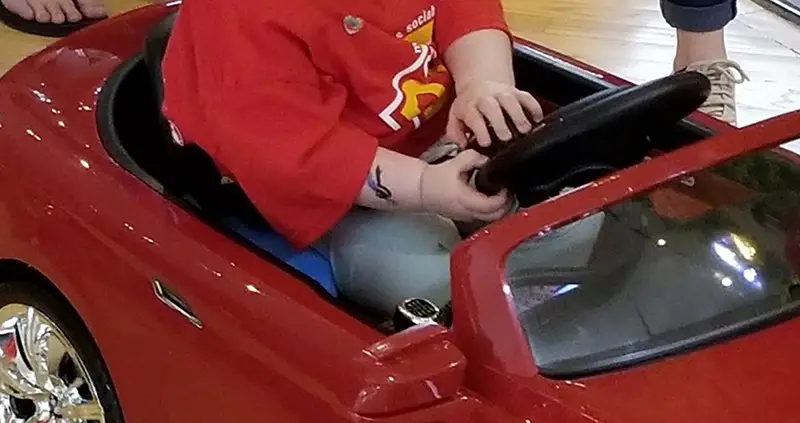 A child demonstrating cognitive abilities and fine motor coordination to push the switch with one hand and steer with the other.
A child demonstrating cognitive abilities and fine motor coordination to push the switch with one hand and steer with the other.
The New Trier students 3D printed steering wheels that were placed on top of the switch, allowing the child to press the activation switch and steer simultaneously.
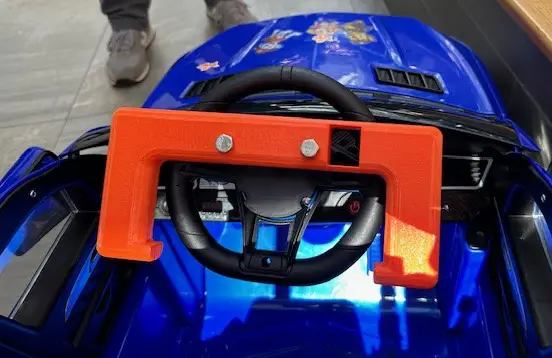 3D printed steering wheels with stop/go switch under the steering modification, allowing for easier coordination for the child to steer.
3D printed steering wheels with stop/go switch under the steering modification, allowing for easier coordination for the child to steer.
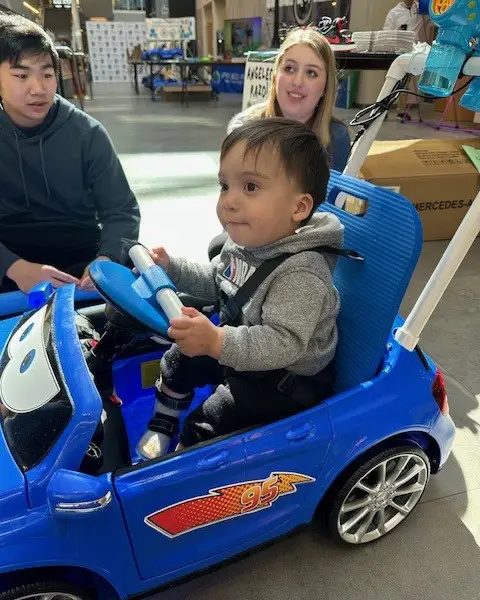 Child demonstrating 3D printed steering wheel modification.
Child demonstrating 3D printed steering wheel modification.
I worked with the children aged 0-3 years old and their parents, while Nancy McNamara PT from True North school district oversaw therapists and students as children in the school system received larger cars. Positioning needs were addressed, and students created and built their designs under the supervision of the teachers. Sewing modifications for straps, head supports, and shoulder pads were fabricated as well.
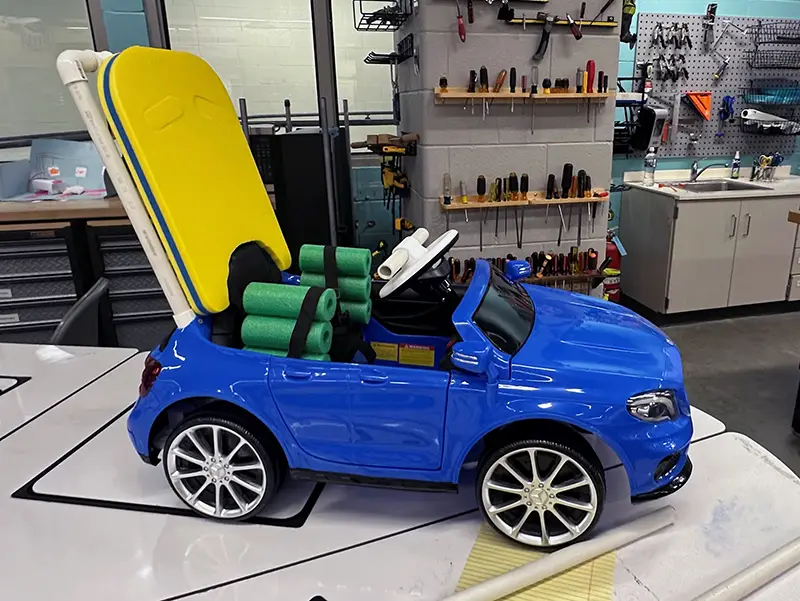 Swing-away trunk supports and a slight seating recline.
Swing-away trunk supports and a slight seating recline.
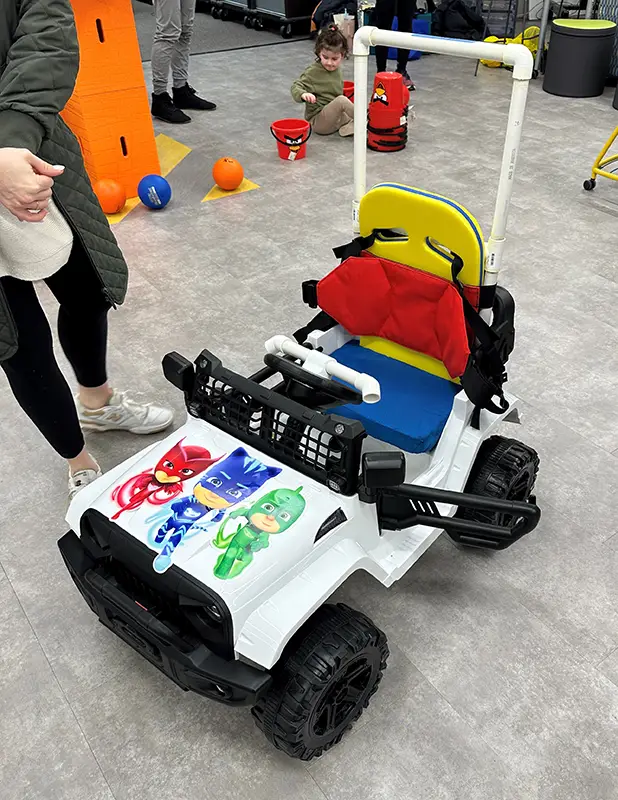 Seating intervention with posterior and circumferential support.
Seating intervention with posterior and circumferential support.
Many families were excited for their children to be able to operate the stop/go switch, but the steering was beyond some children's capabilities. These children's parents stepped in to steer, which resulted in the adults having to bend over the car to control the steering wheel.
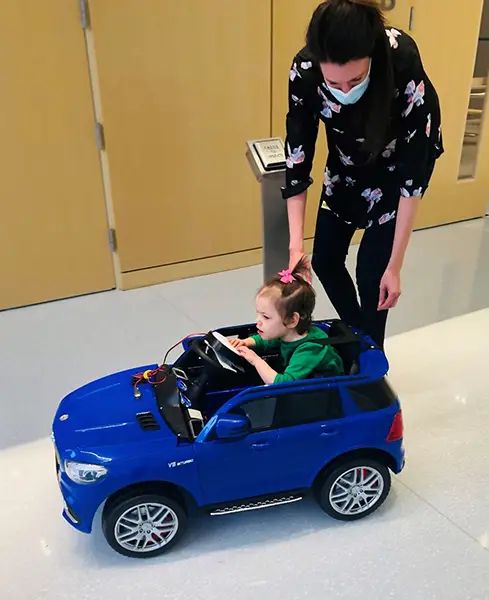 A mother bent over the car, getting ready to assist with steering.
A mother bent over the car, getting ready to assist with steering.
The engineers at the Shirley Ryan AbilityLab designed a device that holds the front wheels and has a platform that allows parents to steer without having to bend down to the steering wheel.
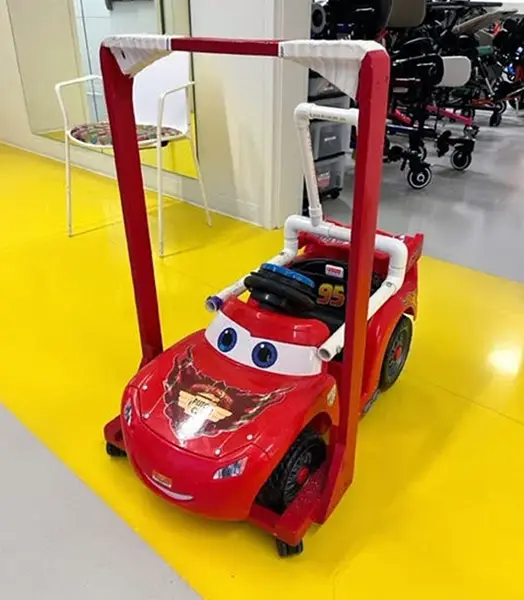 Modified platform which holds the front wheels and allows an adult to steer without bending over. Photo courtesy Shirley Ryan AbilityLab and used with permission.
Modified platform which holds the front wheels and allows an adult to steer without bending over. Photo courtesy Shirley Ryan AbilityLab and used with permission.
This year, the New Trier Foundation funded GoBabyGo cars with remote controls, eliminating the problem of steering for children who are unable to do so. Some of the children require hangers for g-tube feeders or IVs. Others need supports for their portable oxygen devices. The students at New Trier designed unique modifications to meet each child's individual needs.
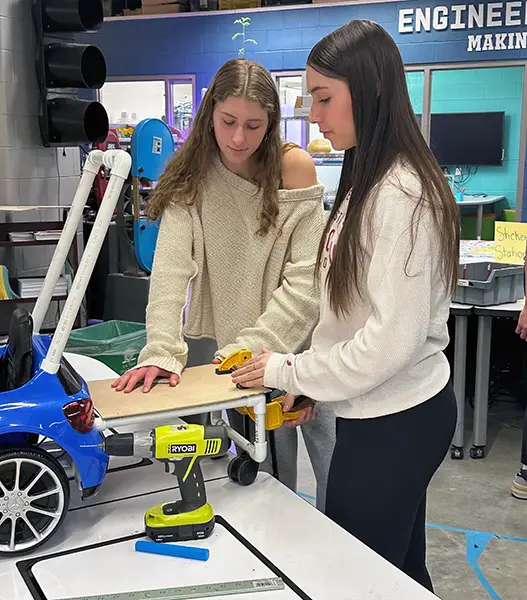 STEAM students designing portable oxygen holders.
STEAM students designing portable oxygen holders.
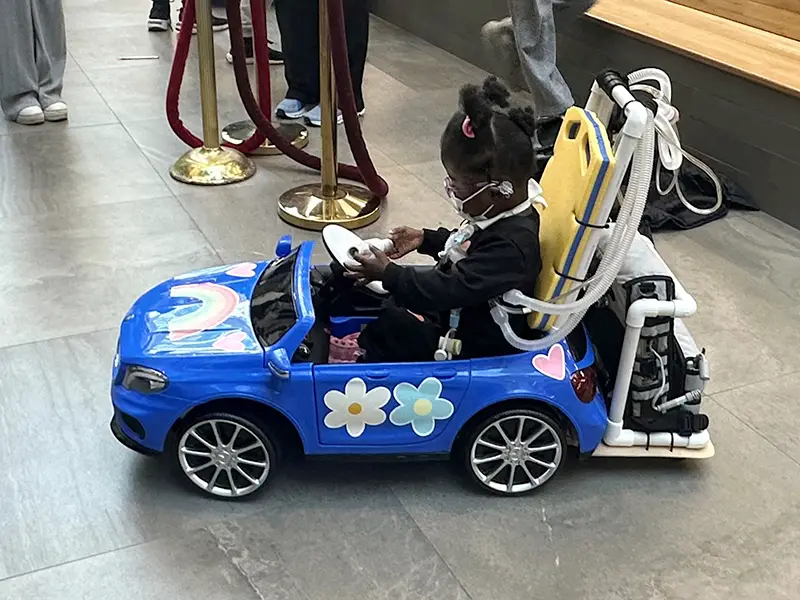 This child is able to independently use her GoBabyGo car, which has been modified to support her portable oxygen supply.
This child is able to independently use her GoBabyGo car, which has been modified to support her portable oxygen supply.
The Director of Illinois Spina Bifida Foundation Matt Larsen and I met with Applied Arts Program of New Trier to discuss the outcomes and plan the project for the following year. The New Trier staff's interest has grown based on observations of teachers and students who are not part of the classes doing the build. This year, the child development classes participated by coming up with toys that the children could interact with while waiting for the STEAM students to make modifications. The staff from the fashion design program came with sewing machines to fabricate anterior chest straps and shoulder pads as needed for each child.
This year, a local TV station was present to interview students, staff, and families involved in the build. New Trier also interviewed students about their feelings regarding the program.
This program allows students to participate in creating functional, usable products with immediate feedback for those involved. It increases a teenager's opportunities to meet children with disabilities and interact with their parents to gain a better understanding of the child, the home situation, and their environment. Inclusion is often a goal, and the modified car provides a cool way for them to get involved with other children in a playful environment. It is hoped that this will become a model program for other high schools in the Illinois area interested in creating the same opportunities for their students and staff.
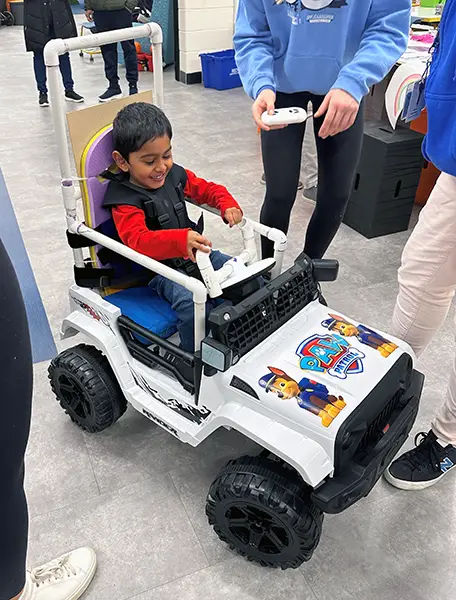 Child demonstrating the joy of moving independently. "Get me to the playground!"
Child demonstrating the joy of moving independently. "Get me to the playground!"
References
- Adolph, K. E., & Hoch, J. E. (2020). The Importance of Motor Skills for Development. Building Future Health and Well-Being of Thriving Toddlers and Young Children, 95, 136-144.
- Casey, J., Paleg, G., & Livingstone, R. (2013) Facilitating child participation through power mobility. British Journal of Occupational Therapy. 76(3):158-160.
- Feldner. (2019). Impacts of Early Powered Mobility Provision on Disability Identity: A Case Study. Rehabilitation Psychology, 64(2), 130–145. https://doi.org/10.1037/rep0000259
- Field, D.A. & Livingstone, R. (2018). Power mobility skill progression for children and adolescents: a systematic review of measures and their clinical application. Developmental Medicine & Child Neurology
- Field, D.A., Miller, W.C., Jams, T., Ryan, S.E., & Roxborough, L. (2015). Important elements of measuring participation for children who need or use power mobility: A modified Delphi survey. Developmental Medicine & Child Neurology. 57(6):556-563.
- Kenyon, L., Blank. K., Meengs J., & Schultz, A. (2002). Key Aspects of Power Mobility Interventions for Children: A Qualitative Study. Proceedings International Seating Symposium 2022.
- Kenyon, L.K., Mortenson, W.B., & Miller, W.C. (2018). Power in Mobility: parent and therapist perspectives of the experiences of children learning to use powered mobility. Developmental Medicine & Child Neurology 60: 1012–7.
- Kenyon, L. K., Farris, J., Brockway, K., Hannum, N., & Proctor, K. (2015). Promoting self-exploration and function through an individualized power mobility training program. Pediatric Physical Therapy, 27(2), 200-206.
- Nilsson, L. M., & Nyberg, P. J. (2003). Case report—Driving to learn: A new concept for training children with profound cognitive disabilities in a powered wheelchair. American Journal of Occupational Therapy, 57, 229–2
- Pellichero, Kenyon, L. K., Best, K. L., Lamontagne, M.E., Lavoie, M. D., Sorita, É., & Routhier, F. (2021). Relationships between Cognitive Functioning and Powered Mobility Device Use: A Scoping Review. International Journal of Environmental Research and Public Health, 18(23)
- Rivera, M. (February 29, 2024). Local HS Students Gives Kids with Mobility Issues Chance to Move. ABC Chicago Local News. https://abc7chicago.com/videoClip/14480932/
- Rosen, L., Plummer, T., Sabet, A., Lange, M., Livingstone, R. (2017). The RESNA position on the application of power mobility devices for pediatric users-Update. RESNA 2017
- Sabet, A., Feldner, H., Tucker, J. Logan, S., Galloway, J. C., (2022). ON TIME mobility: Advocating for Mobility Equity. Pediatric Physical Therapy 34 546-560
- University of Delaware. (n.d.). GoBabyGo! https://sites.udel.edu/gobabygo/
With over 40 years of clinical practice as an OT, Jessica Presperin has worked in all sectors of the wheelchair and seating industry as a master clinician, supplier, manufacturing consultant, design representative, and educator. Dr. Presperin was a pioneer in the development of the profession of wheelchairs and seating in the 1980s and has spent the last two decades contributing to the research world to demonstrate evidence for knowledge translation in the clinic, advocacy, and product development. She is a RESNA and AOTA Fellow, serves on the Clinician Task Force, the Seating and Wheeled Mobility Committee for AOTA, and has shared her experiences internationally through publications and presentations.